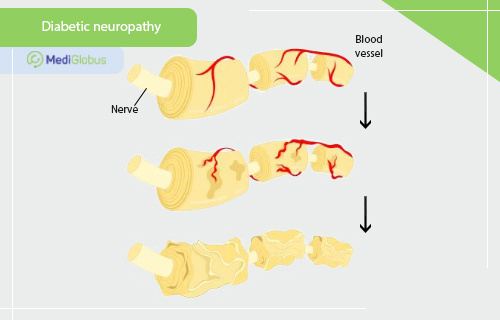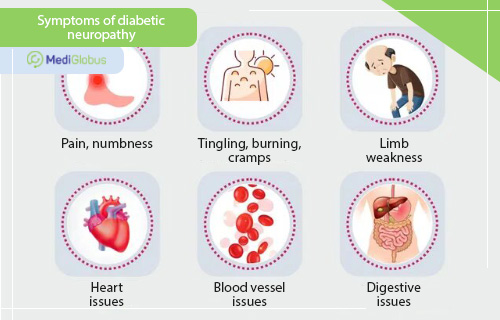Diabetes has been called ‘the biggest global epidemic of the 21st century’. According to the International Federation of Diabetologists, more than 425 million people worldwide are living with this diagnosis. Diabetes mellitus brings with it many unpleasant consequences for the patient’s health, one of the most common being diabetic neuropathy. 30-50% of patients live with constant pain due to neuronal damage. It is believed that diabetic neuropathy cannot be cured, but is this true? How advanced medicine answers this question – read our article.
What is diabetic neuropathy?

Diabetic neuropathy is a lesion of the peripheral nerves that occurs in patients with diabetes mellitus. The disease can occur in both type 1 and type 2 diabetes, but it is more common in the latter.
The cause of the development of diabetic neuropathy is high glucose and triglycerides in the blood. They have a destructive effect on the structure of neurons along their entire length, disrupting their normal functioning. Usually, the most distant neurons, located in the legs, begin to suffer first. However, any other area of the body – arms, head, trunk, etc. can also be involved.
There are 4 major subtypes of diabetic neuropathies. A person with diabetes may have more than one focus of the disease.
Peripheral diabetic neuropathy
The most common form of the disease – occurs in 75% of patients. The damage occurs in the nerve endings located in the feet and legs, as well as palms and hands.
Autonomic diabetic neuropathy
Damages nerves leading to internal organs – heart, bladder, stomach, intestines, genitourinary system, etc. Diagnosed in one-third of patients.
Focal diabetic neuropathy
Usually manifests itself in the form of compresssed nerves, such as tunnel syndrome. The disease typically affects nerves located in the wrist, legs, trunk or head.
Proximal diabetic neuropathy
Affects neurons in the thigh and buttocks – usually on one side only. Symptoms may improve on their own over several months or years.
The symptoms of the disease depend on the type of neuropathy.
All patients diagnosed with diabetes are at risk for developing neuropathy, but some factors are more aggravating. One of the most important is the age of the patient, and how many years he or she has had diabetes. Nerve damage accumulates over time, and the longer a person is in this status, the higher the risk of neuropathy.
In women, unlike men, diabetic neuropathy is more likely to be accompanied by pain. Some forms of the disease are painless, especially in the first stages, which does not make them less dangerous – loss of sensation in the extremities can lead to neglected injuries.
Other risk factors include being overweight, smoking, alcohol abuse, high blood pressure, high cholesterol, genetic predisposition, and accompanying kidney disease.
TRAVEL ABROAD FOR DIABETES TREATMENT
To make an appointment for diabetes treatment abroad, click on the button below and fill in the form. Our coordinators will call you back as soon as possible. They will provide all the necessary information and help you with travel arrangements.
Symptoms of diabetic neuropathy
Damage to neurons can take years to accumulate. Symptoms develop gradually, and in the first stages, the patient may not suspect the presence of neuropathy. Over time, the disease can lead to chronic pain.
The most common form of the disease affects the legs, in particular the feet, and much attention is paid to this aspect. Peripheral neuropathy leads not only to painful sensations while walking, but also to the formation of wounds, sores, calluses, and infections. Impaired coordination of movement also becomes a frequent problem. Due to impaired sensitivity, the patient may not realise that a dangerous foot injury has occurred and may not start treatment in time. Wounds in people with diabetes heal worse, and in the most severe cases can lead to diabetic foot and require amputation.
Another group of dangerous problems is related to autonomic neuropathies. Patients can suffer from ‘hypoglycemia unawareness’. This is a condition in which a person does not feel when glucose levels drop to dangerously low readings and therefore cannot take the necessary action in time. Autonomic neuropathies can also cause:

Blood pressure disorders;
Heartbeat abnormalities;
Digestive issues;
Diseases of the genitourinary system.
The listed symptoms strongly affect the quality of life of the patient, causing loss of efficiency, depression and anxiety disorders.
Diagnosis of diabetic neuropathy
Early diagnosis of diabetic neuropathy gives the best prognosis for the treatment of the disease. Usually, patients go to the doctor with the appearance of the first symptoms, but it is important to understand that not all pain guarantees the diagnosis of ‘diabetic neuropathy’. Many diseases are capable of manifesting themselves in this way, so the process of making a diagnosis always involves a thorough collection of medical history and examinations.
Physical examination by a neurologist includes checking reflexes and muscle tone, as well as specific testing – sensitivity of the limbs to touch, temperature, vibration, etc.
The patient may be prescribed:
Ultrasound examination;
Electromyography;
Biopsy;
Nerve conduction studies.
The standard package of diagnostic procedures for diabetes also always includes blood tests, with special attention to glucose and cholesterol levels.
TRAVEL ABROAD FOR DIABETES TREATMENT
To make an appointment for diabetes treatment abroad, click on the button below and fill in the form. Our coordinators will call you back as soon as possible. They will provide all the necessary information and help you with travel arrangements.
Treatment methods for diabetic neuropathy
Treatment methods for diabetic neuropathy are varied. An experienced specialist selects an approach based on the type of disease and individual symptoms observed in the patient.
Among the drugs used in the treatment of diabetic neuropathy, the following groups are distinguished:
Painkillers | To relieve the patient’s condition, doctors prescribe painkillers and anti-inflammatory drugs in the form of pills and creams. The choice of medication depends on many factors: the intensity of pain, side effects, tolerability of drugs, combination with other drugs, etc. |
Anticonvulsant drugs | Anticonvulsant drugs can relieve the pain of diabetic neuropathy. According to a Cochrane study, up to half of patients experience relief from their symptoms. |
α-Lipoic acid | This is a dietary supplement that has medical benefits in the treatment of diabetic neuropathy. Up to 51% of patients see an improvement in their well-being. |
Surgical treatment for diabetic neuropathy
For some patients, surgery may be the best option for treating neuropathy. A special procedure called nerve decompression can be used effectively to treat the pain and complications of diabetic peripheral neuropathy, reversing symptoms of numbness and tingling, and preventing amputation.
Studies show up to an 88% success rate for the surgeries performed. However, the percentage of patients requiring this form of treatment is quite low, and for most, alternative treatments are better suited.

Treatment of diabetic neuropathy with stem cells
The main problem with diabetic neuropathy is that the process is considered irreversible. To date, the only method that has the potential to treat the cause of the disease rather than the symptoms is stem cell therapy.
Stem cells can differentiate into the cells needed to repair damaged peripheral nerves and blood vessels. During treatment, adult stem cells and growth factors are injected into damaged areas to reduce pain and improve blood supply to the nerves.
The method is still experimental and will require much more research before it is widely used. However, interim results are encouraging and there are already specialist cell therapy centres helping diabetic patients.
Transcutaneous Electronic Nerve Stimulation (TENS)
This is a non-invasive treatment for chronic pain that uses pulses of low-voltage electrical current to target problem nerves. Reports from the American Academy of Family Physicians (AAFP) confirm the moderately positive effects of this treatment for diabetic neuropathy.
Biofeedback Method
This method is used specifically to treat patients with peripheral diabetic neuropathy of the legs. It monitors the involuntary reactions of the body, helping the patient to control them better. The method helps not only with pain relief but also with improved walking. Biofeedback therapy can help teach a person to walk in a way that reduces pressure on certain areas of the foot, allowing ulcers to heal and preventing the need for further treatment.
How to prevent diabetic neuropathy from developing or worsening?

The main focus in the management of patients with diabetes is on preventing diabetic neuropathy rather than treating it.
The most effective way to control the disease and prevent complications (such as diabetic foot) is to control blood glucose and lipid levels. This includes eating a healthy diet high in protein and low in carbohydrates. Fast food and convenience foods are recommended to be eliminated from the diet, as are bad habits akin to smoking and alcohol.
Normalising body mass index is also an important component of preventing diabetic neuropathy. Studies have shown that even small weight loss (1-2kg) can reduce patients’ pain levels.
Diabetic patients are usually advised to engage in regular moderate exercise. This carries its benefits not only through weight loss but also by increasing the body’s sensitivity to insulin.
A normal sleep schedule and an adequate amount of rest play a key role in managing the condition of diabetic patients. Sleep is necessary for the body to recover after a day’s work; in addition, fatigue has been proven to trigger cravings for foods rich in simple carbohydrates.
Diabetic patients should pay special attention to foot hygiene. Because of the loss of sensation associated with diabetic neuropathy, a person may not notice if they develop a callus, ulcer or ingrown toenail. Keeping the feet clean will help protect them from injury and prevent further complications such as infections.
Where to treat diabetic neuropathy abroad?
Prices for diabetic neuropathy treatment depend on the treatment plan recommended by the doctor. You can consult an experienced specialist and travel for diabetes treatment abroad quickly and comfortably by contacting MediGlobus coordinating doctors.

Summary
Diabetic neuropathy is a common complication of type 1 and type 2 diabetes mellitus. Common symptoms of the disease include loss of sensation in the extremities, internal organ dysfunction, and chronic pain. The most dangerous complication is diabetic foot.
Diagnosis of diabetic neuropathy is predominantly symptomatic and may involve electromyography, nerve conduction studies, ultrasound, blood tests and biopsy.
Treatment of diabetic neuropathy is predominantly medication. Alternative methods also include transcutaneous electronic nerve stimulation, biofeedback therapy and surgical nerve decompression.
The most revolutionary treatment for diabetic neuropathy is stem cell therapy. This method is still being researched, but has shown encouraging results and is already being used in selected medical centres.
All patients diagnosed with diabetes are advised to monitor their blood glucose levels and BMI to prevent diabetic neuropathy.
If the disease does occur, MediGlobus, an international medical tourism platform, recommends that you only go to trusted specialists, such as the Cellthera Clinic (Czech Republic), Stembio Centre (Turkey), Liv Ulus Centre (Turkey), Navarra Clinic (Spain), SoonChunHyang Hospital (South Korea).
Stay with MediGlobus and keep up to date with the latest news on the latest developments in foreign medicine. If you need help from a medical specialist abroad – leave an appointment. Our coordinators will help you find a clinic that offers a treatment program that will help you.
Sources:
- 1. National Institute of Diabetes and Digestive and Kidney Diseases: Diabetic Neuropathy
- 2. Nature Reviews Disease Primers: Diabetic neuropathy
- 3. Diabetes Care: Diabetic Neuropathy: A Position Statement by the American Diabetes Association
- 4. Cochrane Library: Antiepileptic drugs for neuropathic pain and fibromyalgia ‐ an overview of Cochrane reviews
- 5. Medcentral: Nerve Decompression Surgery Can Reverse Neuropathy of the Foot
- 6. Brain Sciences: Stem Cell Therapy in Diabetic Polyneuropathy
- 7. American Family Psysician: TENS Helpful for Management of Diabetic Neuropathy Pain






